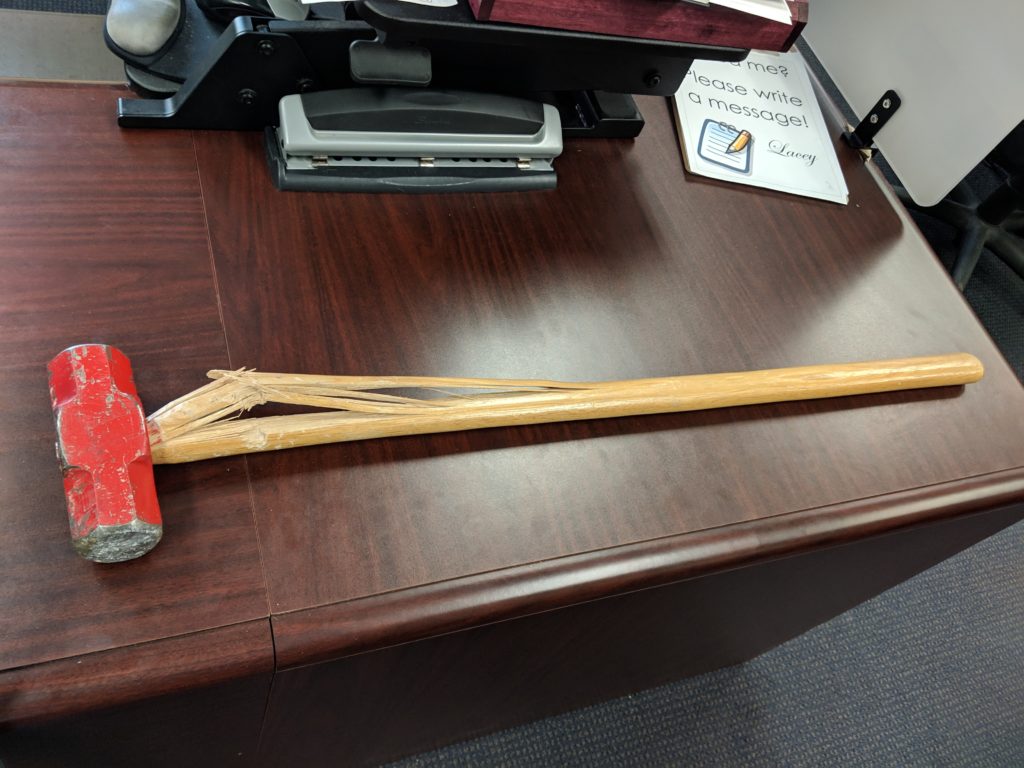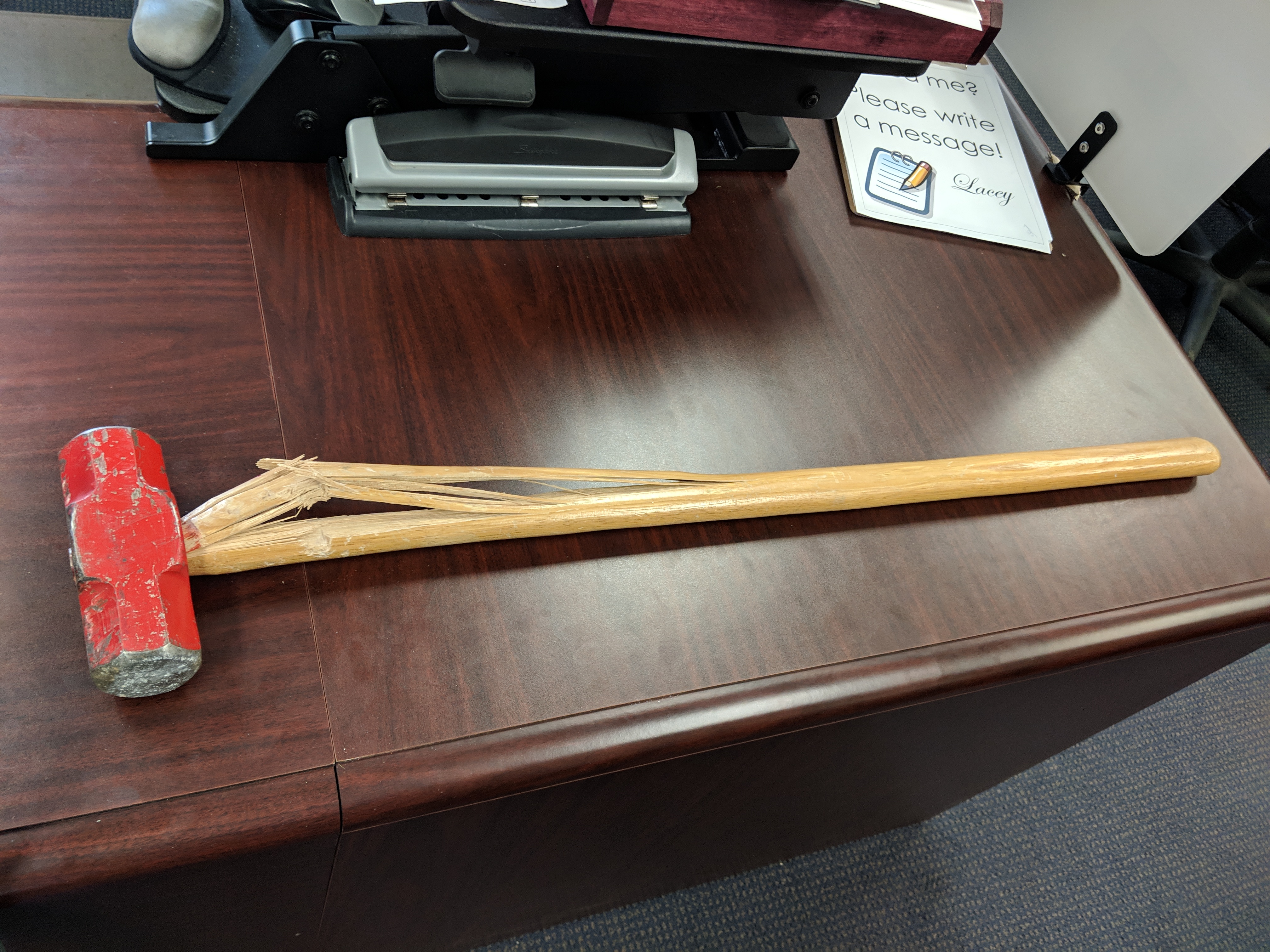Any person with a minimum sufficient experience in life has been rewarded with failure. A subset of those people, with sufficient practice, will come to recognize failure, not as a friend, but as a teacher. A recent useful (and ultimately harmless) failure in my class became a key teaching moment, and may serve as a template to others to how to incorporate failure into teaching without disrupting the larger arc of a class
The “Bed-of-Nails” Demonstration
The “bed-of-nails” demonstration is a staple of my course. I’ll be the first to admit that compared to many of my colleagues I prefer a little extra “flare” in the presentation. The way I learned to do the demo (a useful way to discuss intersections of force, energy, and momentum) was as follows:
- Lay down on a large bed of nails (SMU’s has 3000 nails, 2 per square-inch, which means each nail typically supports far less than 1lb of weight; that’s important, because 1lb of weight is the threshold for pain/serious discomfort on skin.)
- Have an assistant place on your chest a second, much smaller bed of nails (just enough to cover the upper torso).
- On the up-facing side of the smaller bed of nails, rest a cinder block. Make sure the holes of the block are aimed along the long axis of the bed of nails (head-to-toe). It’s important to note at this stage that the person on the bed of nails should have face protection (a covering or shield) and should tuck their arms under the edges of the smaller bed of nails).
- The assistant then swings a sledgehammer and smashes the cinder block. The swing should have a force between that achieved by letting the hammer head (an 8lb hammer head) fall purely under gravity (while gripped in the hands of the assistant the whole time) and being pushed with moderate force in addition to gravity alone. The goal is to break the top layer and middle layer of the cinder block, but not punch through the base layer of material.
The physics of this – why the person on the bed of nails is ultimately safe, apart from getting pelted by flying debris – is (in part) as follows:
- In order to “get through the cinder block” the hammer has to use up kinetic energy to break the chemical bonds in the cinder block material. This inelastic collision uses up essentially all of the kinetic energy of the falling hammer head, leaving nothing significant in the motion of the hammer by the time it reaches the bottom layer of the cinder block.
- The cinder block serves as an “airbag,” spreading the impulse (change in momentum) of the hammer out over a longer time than would be present if the hammer were simply to strike the small bed of nails and stop. This decreases the average force on the person and the hammer, in addition to the energy wasted in shattering the block reducing the final kinetic energy of the hammer.
In previous semesters, the biggest “enemy” of this demonstration has been that the assistant underestimates the force required to make it through the top and middle layers of the cinder block. We’ve learned that falling purely under gravity, with our old hammer, was sufficient to get only through the top layer. This observation was turned into humorous commentary about the attitude of the cinder block in the “mockumentary” I made about the making of my introductory physics course:
A New Failure

We were surprised by a new failure mode. It’s not like I hadn’t anticipated this could happen – I just had no idea that it would when it did. One failure mode of this demo is for the hammer head to break off the hammer handle. I anticipated this. The trajectory of the hammer head, at speed, would take it over my head; if it hit my head, that is covered by the face shield. Best-case scenario was the hammer head becomes detached after impact and falls under gravity; again, here it would be about 8lbs hitting the face shield, which should take most of the blow.
Well, this failure mode finally happened – but not the way I had expected. We did two training runs of the demonstration on Monday night. Tuesday morning was the classroom demonstration. My teaching assistant (whom we had nicknamed “Thor” given his appearance with the hammer in our teaser posters from the beginning of the semester) swung at the block. He had a fairly clean hit, if off-center, and something broke – I heard something break. But it wasn’t the cinder block; instead, the hammer handle split down the long axis, rendering the hammer useless.
I exploded into laughter when I realized how the failure had occurred.
Later that night, I ran out and bought two new hammers, so that we have a primary and a backup for the future. That was lesson 1 of this failure.
The fact that this semester is “Marvel-themed” in my course, and the fact that I have referred to the old sledgehammer as “Mjolnir” (Thor’s first hammer in the comics and movies) since I started teaching the course, and the fact that my teaching assistant nicknamed “Thor” took a swing at the cinder block with Mjolnir and destroyed Mjolnir in the process, was too much to me like the plot of “Thor: Ragnarok”. The parallels were so hilariously stunning that I was inspired to make a “Previously on…” movie short for the start of the next class.
Using the new hammer, (of course, named “Stormbreaker”) we redid the demonstration on the next class day (Thursday, today). It went off without a hitch, as it should have the first time.
There are many lessons in this. The most obvious was “have two hammers.” The less obvious one has to do with materials. Materials will fail. This has to be factored into every decision you make on the engineering side of your life. Handles will break. Metal will crack. Adhesive will become less sticky. Nothing lasts forever. This is the nature of a world based on the laws of physics we already know, and is firmly reflected in nature. I was inspired by a talk given about a decade ago at a Texas American Physical Society meeting; a professor spoke about how he integrates failure into his introductory physics class by showing students how basic mechanics is enough preparation to think about the reasons why and how materials ultimately fail. This hammer failure is an excellent example of that.
Wood is most likely to crack along its grain. This is the direction of weakest cohesion in wood. Transverse to the grain, wood is sturdy; along the grain, wood is weak. The hammer handle split along the grain. This was predictable, even if the time of the failure was not. In addition, wood provides another lesson: in prime condition, even when it fails it won’t fail completely rip apart as long as it isn’t rotted or brittle. Though the handle split, it ultimately didn’t crack entirely apart. This kept the hammer head from flying through the air and saved me a collision with my face shield. Smart design of a material, assuming it can crack, can prevent the crack from becoming a catastrophe.
Failure teaches us many things. It’s important to listen.




